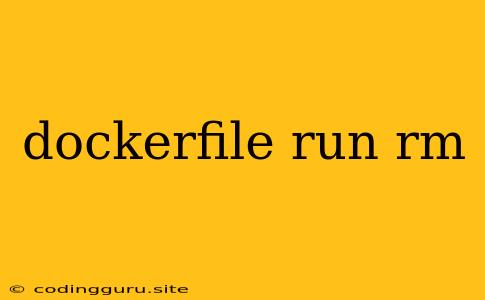Understanding Dockerfile, Run, and Rm: A Guide to Containerization
Docker has revolutionized the way we build, deploy, and manage applications. It empowers developers to package their applications with all their dependencies into self-contained units called containers, ensuring consistent execution across various environments. Central to this process are Dockerfile, run, and rm commands, which form the foundation of Docker operations.
What is a Dockerfile?
A Dockerfile is a text file containing a series of instructions used to build a Docker image. It serves as a blueprint, defining the steps involved in creating a containerized environment, including installing software, copying files, configuring environment variables, and specifying the base image to build upon.
Example Dockerfile:
# Use the official Ubuntu image as the base
FROM ubuntu:latest
# Install Apache web server
RUN apt-get update && apt-get install -y apache2
# Copy the website files into the container
COPY . /var/www/html
# Expose port 80 for web traffic
EXPOSE 80
# Run the Apache server when the container starts
CMD ["apache2ctl", "-D", "FOREGROUND"]
How to Build a Docker Image:
To build a Docker image from a Dockerfile, you use the docker build command followed by the path to your Dockerfile. For example:
docker build -t my-app .
This command builds an image tagged as my-app from the Dockerfile in the current directory.
What is the run Command?
The docker run command is used to create and start a new container based on a Docker image. It is a crucial command in the workflow, allowing you to interact with your containerized application.
Example docker run Command:
docker run -d -p 80:80 my-app
This command does the following:
docker run: Starts a new container.-d: Runs the container in detached mode (in the background).-p 80:80: Maps port 80 on the host machine to port 80 inside the container.my-app: Specifies the image to use for the container.
What is the rm Command?
The docker rm command is used to remove containers. This is useful for cleaning up unused containers and managing your Docker environment effectively.
Example docker rm Command:
docker rm container_id
This command removes the container with the specified container_id. You can obtain the container_id by running docker ps and listing the running containers.
Best Practices for Using rm:
- Always confirm before deleting containers: Use
docker ps -ato list all containers, including stopped ones, before runningdocker rm. - Remove orphaned containers: Use
docker ps -a -f status=exitedto list exited containers anddocker rm $(docker ps -a -f status=exited -q)to remove them. - Remove images after removing containers: You may want to remove the image used to create the container using
docker rmi <image_id>.
Common Use Cases for docker run:
- Running a single command:
docker run -it ubuntu bashruns a bash shell inside a Ubuntu container. - Running a web server:
docker run -d -p 80:80 nginxstarts an Nginx web server. - Deploying an application:
docker run -d -p 80:80 my-appruns a containerized application.
Integrating dockerfile, run, and rm into your Workflow:
- Define your application environment in a Dockerfile: Create a Dockerfile that specifies the base image, software dependencies, and configurations.
- Build the Docker image: Use
docker buildto create an image based on your Dockerfile. - Run your application in a container: Use
docker runto launch a container based on the built image. - Manage containers effectively: Use
docker psto list containers,docker stopto stop them,docker startto restart them, anddocker rmto remove them.
Troubleshooting with Docker:
When encountering issues with your Docker environment, here are some helpful tips:
- Check the logs: Use
docker logs <container_id>to view the logs of a container. - Inspect the container: Use
docker inspect <container_id>to view the configuration and state of a container. - Use Docker Hub: Search Docker Hub for pre-built images for popular applications and frameworks.
Conclusion:
By mastering the use of Dockerfile, run, and rm commands, you can harness the power of containerization for building, deploying, and managing your applications. These tools are essential for achieving consistency, portability, and efficiency in your development workflow. With the right understanding, you can streamline your application development process and unlock the full potential of Docker.
